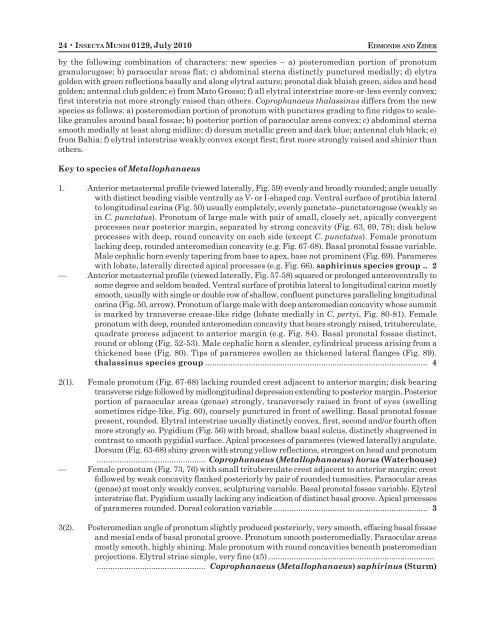insecta mundi - Center for Systematic Entomology
insecta mundi - Center for Systematic Entomology
insecta mundi - Center for Systematic Entomology
Create successful ePaper yourself
Turn your PDF publications into a flip-book with our unique Google optimized e-Paper software.
24 • INSECTA MUNDI 0129, July 2010 EDMONDS AND ZIDEK<br />
by the following combination of characters: new species – a) posteromedian portion of pronotum<br />
granulorugose; b) paraocular areas flat; c) abdominal sterna distinctly punctured medially; d) elytra<br />
golden with green reflections basally and along elytral suture; pronotal disk bluish green, sides and head<br />
golden; antennal club golden; e) from Mato Grosso; f) all elytral interstriae more-or-less evenly convex;<br />
first interstria not more strongly raised than others. Coprophanaeus thalassinus differs from the new<br />
species as follows: a) posteromedian portion of pronotum with punctures grading to fine ridges to scalelike<br />
granules around basal fossae; b) posterior portion of paraocular areas convex; c) abdominal sterna<br />
smooth medially at least along midline; d) dorsum metallic green and dark blue; antennal club black; e)<br />
from Bahia; f) elytral interstriae weakly convex except first; first more strongly raised and shinier than<br />
others.<br />
Key to species of Metallophanaeus<br />
1. Anterior metasternal profile (viewed laterally, Fig. 59) evenly and broadly rounded; angle usually<br />
with distinct beading visible ventrally as V- or I-shaped cap. Ventral surface of protibia lateral<br />
to longitudinal carina (Fig. 50) usually completely, evenly punctate–punctatorugose (weakly so<br />
in C. punctatus). Pronotum of large male with pair of small, closely set, apically convergent<br />
processes near posterior margin, separated by strong concavity (Fig. 63, 69, 78); disk below<br />
processes with deep, round concavity on each side (except C. punctatus). Female pronotum<br />
lacking deep, rounded anteromedian concavity (e.g. Fig. 67-68). Basal pronotal fossae variable.<br />
Male cephalic horn evenly tapering from base to apex, base not prominent (Fig. 69). Parameres<br />
with lobate, laterally directed apical processes (e.g. Fig. 66). saphirinus species group .. 2<br />
— Anterior metasternal profile (viewed laterally, Fig. 57-58) squared or prolonged anteroventrally to<br />
some degree and seldom beaded. Ventral surface of protibia lateral to longitudinal carina mostly<br />
smooth, usually with single or double row of shallow, confluent punctures paralleling longitudinal<br />
carina (Fig. 50, arrow). Pronotum of large male with deep anteromedian concavity whose summit<br />
is marked by transverse crease-like ridge (lobate medially in C. pertyi, Fig. 80-81). Female<br />
pronotum with deep, rounded anteromedian concavity that bears strongly raised, trituberculate,<br />
quadrate process adjacent to anterior margin (e.g. Fig. 84). Basal pronotal fossae distinct,<br />
round or oblong (Fig. 52-53). Male cephalic horn a slender, cylindrical process arising from a<br />
thickened base (Fig. 80). Tips of parameres swollen as thickened lateral flanges (Fig. 89).<br />
thalassinus species group .................................................................................................. 4<br />
2(1). Female pronotum (Fig. 67-68) lacking rounded crest adjacent to anterior margin; disk bearing<br />
transverse ridge followed by midlongitudinal depression extending to posterior margin. Posterior<br />
portion of paraocular areas (genae) strongly, transversely raised in front of eyes (swelling<br />
sometimes ridge-like, Fig. 60), coarsely punctured in front of swelling. Basal pronotal fossae<br />
present, rounded. Elytral interstriae usually distinctly convex, first, second and/or fourth often<br />
more strongly so. Pygidium (Fig. 56) with broad, shallow basal sulcus, distinctly shagreened in<br />
contrast to smooth pygidial surface. Apical processes of parameres (viewed laterally) angulate.<br />
Dorsum (Fig. 63-68) shiny green with strong yellow reflections, strongest on head and pronotum<br />
................................................ Coprophanaeus (Metallophanaeus) horus (Waterhouse)<br />
— Female pronotum (Fig. 73, 76) with small trituberculate crest adjacent to anterior margin; crest<br />
followed by weak concavity flanked posteriorly by pair of rounded tumosities. Paraocular areas<br />
(genae) at most only weakly convex, sculpturing variable. Basal pronotal fossae variable. Elytral<br />
interstriae flat. Pygidium usually lacking any indication of distinct basal groove. Apical processes<br />
of parameres rounded. Dorsal coloration variable .................................................................... 3<br />
3(2). Posteromedian angle of pronotum slightly produced posteriorly, very smooth, effacing basal fossae<br />
and mesial ends of basal pronotal groove. Pronotum smooth posteromedially. Paraocular areas<br />
mostly smooth, highly shining. Male pronotum with round concavities beneath posteromedian<br />
projections. Elytral striae simple, very fine (x5) .........................................................................<br />
................................................ Coprophanaeus (Metallophanaeus) saphirinus (Sturm)



